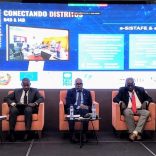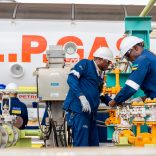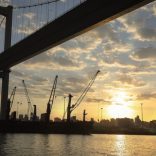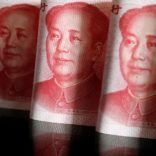Mozambique: World Bank provides US$24 million for PDUNM housing project in Nampula, Cabo Delgado - ...
Mozambique was once self-sufficient in corn flour, rice, oranges… – João José Uthui

A Verdade / João José Uthui
Today, Mozambique imports even cabbages. Before independence, it was one of Africa’s most thriving economies, producing not only enough food for domestic consumption but also for export.
“We did not import corn flour. We ate rice from Zambezia province. We would never buy oranges in South Africa. We were the second-largest copra producer in the world,” Professor Joao Jose Uthui, an advisor of the Mozambican Debt Group (Grupo Moçambicano da Dívida) NGO says in an interview with A Verdade.
For a return to self-sufficiency, Professor Uthui recommends “drawing up an economic development model that allows us to produce using our raw materials, and invest in education and in mechanized agriculture.”
Asked by A Verdade when our country was self-sufficient, the academic begins his diagnosis by saying that his perspective begins before national independence, as he was born and lived since that time.
“I think the big problem we have is that we do not have what is ours; we do not produce anything.”
The ninth largest
“In 1968, 69 and 70, Mozambique was the ninth largest economy in Africa, after the Magreb countries, Nigeria, Angola, South Africa and Zimbabwe. When I tell youngsters today that we once made the blankets they use, they say, this old man always tells jokes, but it’s true. We produced blankets the equal of the ones we get from South Africa with the cotton produced in Nampula. We had blankets of all qualities, from blankets for the floor, blankets for military, for use in hotels and even for export to Europe. We had three blanket factories.”
Uthui says that he won’t even mention the cashew factories, “because the almonds left with our label already on”.
As regards cotton production Uthui notes that the country produced clothes from fabrics produced locally. “We had Riopele, Texlom, Soveste, Texmanta in Mocuba, Fafezal in Zambezia, all producing fabrics or flax sisal cord, spider and cotton web. That’s why João Ferreira dos Santos gave money to the farmers to buy inputs. They tilled the land and he said, this is your field but you do not sell to anyone else, that is for me to buy. And they had the rice, flour and curry guaranteed throughout the year because they knew that the farm produced cotton, and was monoculture.”
“What went wrong after independence? I am not going to talk about it.”
Speaking about food production, Uthui recalls: “We did not buy corn meal from outside the country; the only flour that came from abroad was the wheat to make bread. There was first, second and third grade flour. The rice we ate came from Musselo Novo, in Zambezia province. Lopes & Irmãos had a rice-husking factory in Mucubela in Maganja da Costa. João Ferreira dos Santos in Gaza had the SorGaza factory in Xai-Xai. We had three rice mills in Angoche, working with rice produced here.”
“Cardiga, who owned livestock in Changalane, raised animals on rice bran, produced meat, and processed the hides in the tannery here. Our shoemakers were not going to buy leather in South Africa to make shoes, and we also had shoe factories here. The shoe shops bought shoes from factories here to sell to Mozambicans.”

Professor Uthui says those born after 1975 are unaware of these facts. Mozambique never bought orange from South Africa. “In Mandlakazi (in Inhambane province) there is an area called Laranjeira (“orange grove” in Portuguese), because it produced oranges. Not to mention Manica and Niassa, only here in the South. And the people there made a living out of the oranges produced there, so imagine how many oranges were produced.”
“Do you know that we were the second copra producer country in the world? And we produced soap; we never needed to buy soap abroad because we had it here from our copra”
Pressed on what happened after independence for all this to be lost, Professor Uthui suggests the journalists themselves “go and find out what happened for us to lose it all,” but reluctantly gives some hints.
“I’ll give you an example of a model of land use in Niassa. When Mandela (Nelson) came to power (as President of South Africa) he convinced Chissano (President of Mozambique) to use the land, sending (South African) farmers here. Because Mandela’s goal was for the region to be self-sufficient in terms of agriculture, and knew that Mozambique had large tracts of idle land. They did photo surveillance in a specialized aircraft, and some Boer farmers formed an association called Mozagrius to work the land in Majune. I was one of the individuals from civil society involved in that process,” the academic recalls.
According to Uthui, to get the project moving around 1996, “Mozambique had to put in a few million dollars and South Africa the same amount – it was a partnership of equals. Mandela told Chissano he would send around 500 farmers, and that he should also organize his farmers. Chissano said yes, but he knew he had no farmers, only peasants, smallholders. But he had a growth perspective, and the project was that for every two white South African farmers there would be a Mozambican, and the fields (‘machambas’) would reflect that.”
“You know what happened when policies are not well-designed and private interests get a foot in. The selection of (Mozambican) farmers was a disaster. I wanted to get my mother to speak for me, although I’m no farmer, but I know how to take advantage and get one of my family into the scheme, although he knew nothing about farming.”
“The South Africans named an agricultural economist specializing to direct the project. Dona Maria came from South Africa with her family and settled in Niassa, where the farms were being created. The Mozambican counterpart was an economist; I will not tell you his name, but he lived in Maputo and had to catch a plane to go see the farms, while the Dona Maria was there and visited the South African farmers every day.”
“They settled in Majune initially. A few dozen farmers, who came with their families and were moved into sticks huts. The Mozambican counterpart peasants, some lived in Lichinga.”
According to Uthui, who was involved in the project from the civil society side, the project could never have worked. “The South African farmer living in Majune had a Land Rover to get around, had agricultural machinery, a rain gauge and a silo. He also had a screen connected to the internet via satellite to monitor the cost per kilo of any crop he might plant. The Mozambican had no home in Majune but lived in Lichinga. He had no car to get there, just a bike, so he would not go every day. How would the project ever work? And when we said that the project was going to die, some of my colleagues were threatened. The Boers were angry and left,” the professor concludes.
With the Uthui experience in mind, how does Mozambique reverse the current situation and achieve food self-sufficiency?
By “drawing up a model of economic development that enables us to use the raw material that we produce, invest in education and mechanized agriculture,” the academic replies, but “there has to be the will on the part of the people to seize hold of the money we borrow and invest to produce”.
Uthui is skeptical about the current executive’s policies to increase production. “I would like to be convinced, but I’m not. I want to see application on the ground, not just read about it in the papers and hear it in seminars. In colonial times, I did not need to read that there was a production policy because I saw it. I never ate rice from China then, but I do now.”












Leave a Reply
Be the First to Comment!
You must be logged in to post a comment.
You must be logged in to post a comment.